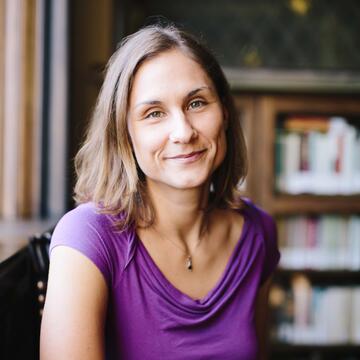
Amalia Kokkinaki
Associate Professor
Biography
An associate professor in the Department of Environmental Science since 2016, Dr. Amalia Kokkinaki holds a PhD degree from the University of Toronto in Canada and joined USF after completing her postdoctoral research at Stanford University. She is an environmental engineer with expertise in groundwater flow, fate and transport of contaminants, and biological treatment of organic pollutants. Her research is in the nexus of mathematical and statistical modeling of the physical, chemical and biological processes governing environmental systems. Amalia teaches undergraduate courses in the environmental science department, and graduate courses in the master’s program (MSEM) and the Geospatial Analysis Lab (GsAL). Amalia is also on the curriculum committee for the new engineering program at USF, and is the adviser for the Environmental Engineering and Science Club at USF.
Expertise
- Groundwater flow and transport
- Contaminant hydrogeology
- Environmental chemistry and microbiology
- Statistical modeling and data assimilation
- Bayesian inverse modeling
Research Areas
- Groundwater remediation of DNAPL source zones
- Data assimilation for subsurface characterization
- Hydrogeophysical methods for monitoring DNAPLs
- Monitoring of carbon dioxide storage in rock formations
- Modeling of treatment methods for organic contaminants
Appointments
- Program Director, MSEM (2023-present)
Education
- University of Toronto, PhD, Civil and Environmental Engineering, 2013
- University of Toronto, MASc, Civil and Environmental Engineering, 2007
- Technical University of Crete, BS and MS, Environmental Engineering, 2005
Awards & Distinctions
- Best reviewer award, Journal of Environmental and Engineering Geophysics (JEEG) 26(3), 2021
- University of San Francisco, Mentor of the Year, 2020
Selected Publications
-
Xing, K., Shi, X., Kokkinaki, A., Yang, Z., Zou, L. and J. Wu (2025) Residual NAPL Architectures in Fractures: Insights From Microfluidic Experiments. Geophysical Research Letters
-
Kang, X., Kokkinaki, A., Shi, X., Lee, J., Guo, Z., Ni, L. and J. Wu. (2024) Modeling Upscaled Mass Discharge From Complex DNAPL Source Zones Using a Bayesian Neural Network: Prediction Accuracy, Uncertainty Quantification and Source Zone Feature Importance. Water Resources Research
- Fu, X., Kokkinaki, A., Shi, X., Yu, J., Gong, X., Zhang, Y., and J. Wu (2023) An ice- air-water-NAPL multiphase model for simulating NAPL migration in subsurface system under freeze-thaw condition, Journal of Contaminant Hydrology, Vol, 257.
- Shi, X., Kokkinaki, A., Kang, X., Hao, S., Gong, X., Zhang, Y., and J. Wu (2023) Comparison of Geostatistical Inversion Methods for DNAPL Source Zone Architecture Characterization, Hydrogeology Journal, Special Issue on Geostatistics in Hydrogeology.
- Kang, X., Kokkinaki, A., Power, C., Kitanidis, P.K., Shi, X., Duan, D., Liu, T., and J. Wu (2022) Integration of deep learning-based inversion and upscaled mass-transfer model for DNAPL mass-discharge prediction and uncertainty assessment, Water Resources Research, 2022, 58(10), e2022WR033277.
- Kang, X., Kokkinaki, A., Kitanidis, P., Shi, X., Lee, J., Mo, S. and J. Wu (2021) Hydrogeophysical Characterization of Nonstationary DNAPL Source Zones by Integrating a Convolutional Variational Autoencoder and Ensemble Smoother. Water Resources Research.
- Ghorbanidenhno, H., Kokkinaki, A., Lee, J. and E. Darve (2020) Recent developments in fast and scalable inverse modeling and data assimilation methods in hydrology, Journal of Hydrology, Vol. 591.
- Kang, X., Kokkinaki, A., Shi, X., Revil, A., Lee, J., Abdellahi, S.A. and J. Wu (2020) Improved characterization of DNAPL source zones via sequential hydrogeophysical inversion of hydraulic-head, self-potential and partitioning-tracer data. Water Resources Research.
- Lee, J., Kokkinaki, A., Kitanidis, P.K. (2018), Fast Large-Scale Joint Inversion for Deep Aquifer Characterization Using Pressure and Heat Tracer Measurements, Transport in Porous Media, 123(3), pp. 533-543
- Ghorbanidehno, H., Kokkinaki, A., Li, Y. J., Darve, E. F. and Kitanidis, P. K. (2017) Optimal estimation and scheduling in aquifer management using a Spectral Linear Quadratic Gaussian Control Method, Advances in Water Resources, 110, pp. 310-318
- Li, J. Y., Kokkinaki, A., E. F. Darve, and P. K. Kitanidis (2017), Smoothing-based compressed state Kalman filter (sCSKF) for joint state-parameter estimation: applications in reservoir characterization and CO2 storage monitoring, Water Resources Research, 53 (8) pp. 7190-7207
- Ghorbanidehno, H., Kokkinaki, A., Li, Y. J., Darve, E. F. and Kitanidis, P. K. (2015), Real time data assimilation for large-scale systems: The Spectral Kalman Filter, Adv. in Water Resources, 86, pp.260-272
- Li, J. Y., Kokkinaki, A., H. Ghorbanidehno, E. F. Darve, and P. K. Kitanidis (2015), The Compressed State Kalman Filter for nonlinear state estimation: Application to large-scale reservoir monitoring, Water Resources Research, 51(12), pp. 9942-9963
- Kokkinaki, A., Werth, C.J. and Sleep, B.E. (2014) Comparison of upscaled models for multistage mass discharge from DNAPL source zones, Water Resources Research, 50(4), pp. 3187-3205
- Kokkinaki, A., O`Carroll, D.M., Werth, C.J. and Sleep, B.E. (2013) An evaluation of Sherwood-Gilland correlations for NAPL dissolution and their relationship to soil properties, Journal of Contaminant Hydrology, 155, pp. 87-98
- Kokkinaki, A., O`Carroll, D.M., Werth, C.J. and Sleep, B.E. (2013) Coupled simulation of DNAPL infiltration and dissolution in three-dimensional heterogeneous domains: process model validation, Water Resources Research, 49(10), pp. 7023-7036
Example Student Projects
-
Chloe Jones-Livingstone (2022-2023): Investigating the Sorption Kinetics of Perfluorooctanoic Acid (PFOA) onto natural soils
-
Theodore Cartales (2023): Impact of organic carbon and solution chemistry on sorption kinetics of PFOA on natural soils
-
Rayyanne Matonding (2023): Column study of PFOA and PFAS sorption onto soils under variable flow conditions
-
Gabriella Chao: Modeling sorption of uranium-Vi on silica sand under variable pH conditions.
- Rhea Quezon, Kirsten Wong, Marisol Castro, Kiernan Hardiman (ENVS): Analyzing temperature and chlorophyll-a trends in the San Francisco Bay
- Abhinav Agrawal (ENGY 2020): Modeling an optimized residential electrification mix of the grid, mini-grid, and standalone technologies
- Majid Alturki, Dayia Masuda, Andrew Egly (CS2019): User friendly graphical user interface for adaptive decision making in water resources management
- Letizia Tjiupek (ENVS2018), Matthew Hanson (ENVM2017): Evaluating Urban Forests Capture Potential of Near-Road PM2.5 in Sacramento, CA.